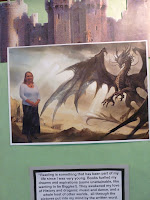 |
Well, let’s start with the entrance. Do books and reading leap out at you the moment you walk in? If not, let’s have book-stands and carousels, posters of the children’s favourite authors, books displayed on tables. Let’s have photographs of the teachers, children and respected members of the local community reading their favourite books. You can have a ‘who’s reading’ competition.
Readers are photographed with just their eyes showing over their book. Get people photographed reading their favourite books in unusual places: the Hundred Mile an Hour Dog on top of a kennel, the Little Mermaid in a swimming pool, Winnie the Pooh with a toy Tigger leaning over their shoulder. Let’s have those books laid out so that they can be borrowed. Have books and bookmarks as prizes.
OK, now we’re cooking. Hopefully there is money in the school budget so you can invite an author, illustrator or poet in to talk to the children and inspire them to pick up a book. If not, get somebody from the library service to read some really cool books. You could have a Skype interview with an author or play clips of them from YouTube. After all, reading is now part of the digital age.
What about those assemblies? Have a teacher, a child and a respected member of the community, a firefighter, nurse, lollipop lady, sports personality or broadcaster introduce the school to their favourite book. Project the front cover behind them as they speak. To support it make posters of all those individuals displayed against backgrounds made of their favourite book setting. Have the head teacher fighting dragons, the caretaker dancing with Mary Poppins or the cook serving Wonka Bars to her or his customers.
Decorate the library with children’s work. They can do book reviews, design book covers, film posters of their favourite book, board games based on it too. They can design bookmarks and character sketches. They can plan out sequels and prequels. They can write their favourite character’s biography, send them a letter or postcard or even make them a birthday card.
Then there is the ubiquitous dressing up day. Don’t just ask the children to dress up as a favourite character. Have themed school lunches with the parents making cakes decorated as book covers or characters. Have a competition for the best one. Make it the Great British Story Book Bake Off.
So let’s create a buzz around World Book Day. Children learn to read best when they read often, widely and for pleasure. Better still, make every day World Book Day.



